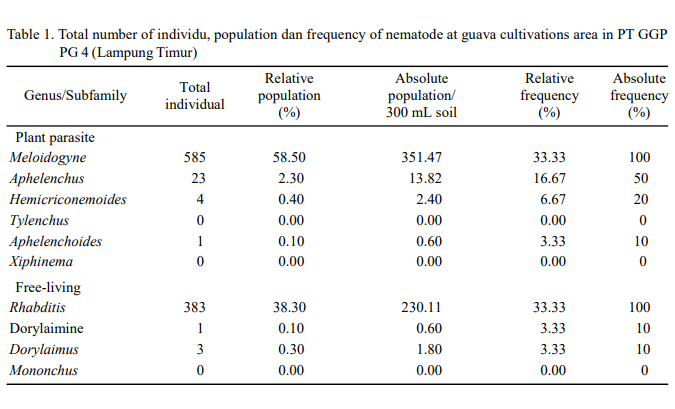DIVERSITY AND ABUNDANCE OF NEMATODES IN GUAVA (Psidium guajava L.) CULTIVATION IN LAMPUNG
Main Article Content
Abstract
Diversity and abundance of nematodes in guava (Psidium guajava L.) cultivation in Lampung. Crystal guava agroecosystem is inhabited by many species of plant parasitic nematodes. However, information regarding this topic was still limited. This study aimed to understand the species dominancy of nematodes in crystal guava cultivation in Lampung. Sampling was carried out in three locations of guava crystal plantations: Lampung Timur, Lampung Tengah, and Tanggamus. The laboratory analysis was done at the Plant Pest Science Laboratory and Agricultural Biotechnology Laboratory, Universitas Lampung. The study was conducted in December 2019 – July 2020. Nematodes were identified to the level of the genus. The Prominance value (PV) was used to assess the nematodes genus dominancy. The results showed that the nematodes inhabiting the crystal guava agro-ecosystem in Lampung was both plant parasitic and free-living nematodes. The plant parasitic nematodes were identified as Meloidogyne, Aphelenchus, Hemicriconemoides, Tylenchus, Aphelenchoides, and Xiphinema, while free-living nematodes was Rhabditis, Dorylaimine, Dorylaimus, and Mononchus. The dominant plant parasitic nematode was Meloidogyne and the dominant free-living nematode was Rhabditis. The abundance of Meloidogyne /300 mL of soil was 351.47 individuals in Lampung Timur, 124.27 individuals in Lampung Tengah, and 82.18 individuals in Tanggamus. The dominant free-living nematode in the three locations was Rhabditis.
Article Details

This work is licensed under a Creative Commons Attribution-NonCommercial 4.0 International License.
References
Agrios GN. 1996. Plant Pathology. Academic Press, California.
Bridge J. 1987. Control strategies in subsistence agriculture. In: Brown RH & Kerry BR (Eds.). Principles and Practice of Nematode Control in Crops. pp. 289–420. Academic Press. Australia.
Barker KR. 1985. Sampling nematode communities. In: Barker KR, Carter CC, & Sasser JN (Eds.). An Advanced Treatise on Meloidogyne Vol. II: Methodology. pp. 2–17. North Carolina State University Graphics, Raleigh.
Beals E. 1960. Forest bird communities in the Apostle Islands of Wisconsin. Wilson Bull. 72(2): 156–181.
Dulbari, Santosa E, Koesmaryono Y, Sulistyono E, Wahyudi A, Agusta H, & Guntoro D. 2021. Local adaptation to extreme weather and it’s implication on sustainable rice production in Lampung, Indonesia. AGRIVITA. 43(1): 125–136.
El-Borai FE & Duncan LW. 2005. Nematode parasities of subtropica and tropical fruit crops. In: Luc M, Sikora RA, & Bridge J (Eds.). Plant Parasitic Nematodes in Subtropical and Tropical Agriculture. 2nd edition. pp. 467–492. CABI Publishing. Walingford UK.
Gafur A & Swibawa IG. 2004. Methods in nematodes and soil microbe research for belowground biodiversity assessment. In: Susilo FX, Gafur A, Utomo M, Evizal R, Murwani S, & Swibawa IG (Eds.). Conservation and Sustainable Management of Below-Ground Biodiversity in Indonesia. pp. 117–123. Unversitas Lampung. Lampung.
Goodey JB. 1963. Soil and Freshwater Nematodes. Mathuen and Co Ltd. London.
Hooper DJ, Hallman J, & Subottin SA. 2005. Methods for extraction, processing and detection of plant and soil nematodes. In: Luc M, Sikora RA, & Bridge J (Eds.). Plant Parasitic Nematodes in Subtropical and Tropical Agriculture 2nd Ed. pp. 53–86. CABI Publishing. Walingford UK.
Hafif B, Mawardi R, & Utomo JS. 2017. Analisis karakteristik lahan dan mutu biji pala (Myristica fragrans Houtt) daerah Lampung. Jurnal Littri. 23(2): 63–71.
Khan MR, Hassan A, Ghosh B, Das B, Ghosh S, & Ray SK. 2007. Diversity and community analysis of soil nematodes associated with guava from West Bengal, India. Acta Hortic. 735: 483–487.
Luc M, Bridge J, & Sikora RA. 2005. Reflections on nematology in subtropical and tropical agriculture. In: Luc M, Sikora RA, & Bridge J (Eds.). Plant Parasitic Nematodes in Subtropical and Tropical Agriculture 2nd Ed. pp. 1–10. CABI Publishing. Walingford UK.
Luckyana DR, Puspitasari IGAA, & Maharning HR. 2020. Bacterial (9A2H) enhancement alters the nematode community structure and decomposition pathway of amended nutrient-limited soil. Biodiversitas. 21(10): 4813–4820.
Mai WF & Lyon HH. 1975. Pictorial Key to Genera of Plant-Parasitic Nematodes. Cornell University, London.
Milan AR. 2007. Breeding of Psidium species for root knot nematode resistance in Malaysia. Acta Hortic. 735: 61–69.
Muin A. 2008. Nematologi Tumbuhan; Biologi, Ekologi, dan Pengendalian. IPB Press, Bogor.
Pradhan P, Patra MK, & Sahoo NK. 2020. Association of nematodes with fruit crops in Bhubaneswar, India. Int. J. Curr. Microbiol. App. Sci. 9(5): 1918–1923.
Rahman MA, Najah Y, & Umikalsum MB. 2008. Preliminary screening for Meloidogyne incognita resistance in selected Psidium species. J. Trop. Agric. Food Sci. 36(2): 1–8.
Razak AL & Lim TK. 1987. Occurence of the root-knot nematode Meloidogyne incognita on guava in Malaysia. Pertanika. 10(3): 265–270.
Seinhorst JW. 1959. A rapid method for the transfer of nematodes from fixative to anhydrous glycerin. Nematologica. 4(1): 67–69.
Shurtleff MC & Averre III CW. 2000. Diagnosing Plant Diseases Caused by Nematodes. American Phytopathological Society. St Paul, Minnesota.
Smart GC & Nguyen KB. 1988. Illustrated Key for the Identification of Common Nematodes in Florida. University of Florida, Florida.
Swibawa IG, Saputri ER, Yulianti E, Fitriana Y, & Solikhin. 2018. Nematoda puru akar dan cendawan parasitnya pada pertanaman jambu biji di Lampung. In: Khaeruni A, Tufaila M, Muhidin, Sutariati GAK, Rahayu M, Bande LOS, Gusnawaty HS, Hidayat SH, Baharuddin, Rosmana A, Kuwinati T, Budi IS, Lisnawita, & Sriwati R (Eds.). Prosiding Seminar Nasional dan Kongres Perhimpunan Fitopatologi Indonesia. pp. 442–450. Universitas Halu Oleo, Kendari.
Yanto & Swibawa IG. 2016. Status fitonematoda pada tiga kisaran umur lahan pertanaman pisang Cavendish di Way Kambas, Lampung. JFI. 12(3): 83–88.
Yeates GW, Bongers T, De Goede RGM, Freckman DW, & Georgieva SS. 1993. Feeding habits in soil nematode families and genera-an outline for soil ecologists. J. Nematol. 25(3): 315–331.

